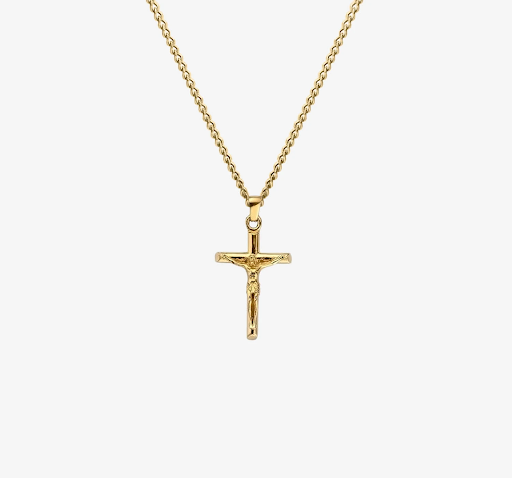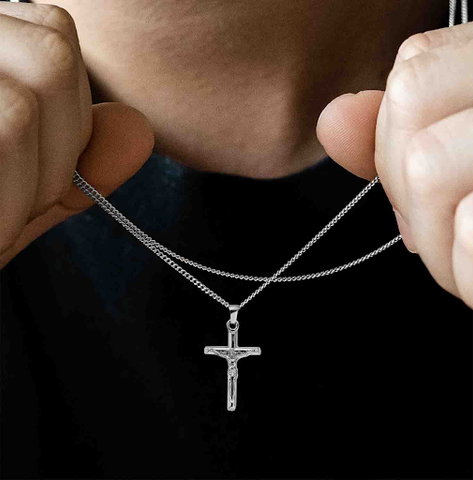
The History of the Crucifix Necklace
Lester Fangonilo - October 5, 2021
Around the world, regular people and many celebrities are marking their faith through fashion accessories such as cross pendant necklaces. To understand why it’s so popular, let’s take a walk through history and trace the origins of the crucifix necklace.
Throughout the history of Christianity, the cross has long been considered a symbol of faith: a lasting reminder of the redemption of humanity through Christ’s sacrifice through crucifixion.
Crosses in the Early Christian Era

The Birka cross pendant was one of the first forms of Christian ornaments to be produced in Scandinavia; this example was found in Denmark
The cross has been used in Christian iconography. It is usually paired with the Greek ichthyos [fish] motif. Since the beginning of the religion, actually wearing a cross as a pendant around one’s neck did not come into play until around the 2nd Century AD. Around this time, the philosopher Tertullian referred to Christians as “devotees of the cross.” This prompted many adherents of the faith - now free from the threat of discrimination and martyrdom - to wear this visible symbol around their necks.
At the time, these were simple wooden crosses that were strung onto thin strips of leather. Over time, more prosperous Christians would have crosses made with precious metals and gemstones commissioned as gifts for high-ranking clergymen who would wear these on elaborate chains around their necks as a visible symbol of their authority.
This is something which continues to this day with the pectoral cross, a large pendant often depicting the crucified Christ, worn by the Pope, as well as Catholic cardinals and bishops, bishops of the Anglican and Episcopalian churches, and members of the Eastern Orthodox clergy.
The Rise of the Reliquary

Elaborate gold tamburin pendants were worn by devout women of quality in the Philippines
Archaeologists who have dug through the sites of ancient churches or cities have noted that the use of crosses and crucifixes as personal ornamentation began to flourish around the 6th Century AD.
Artefacts dug up in the Mediterranean dating from the period have included cross and crucifix pendants that are either hollow or have a circular chamber built into them. These are referred to as reliquaries or small containers for sacred relics.
Many of those discovered were crafted around the time that the True Cross was allegedly discovered in the outskirts of Jerusalem. It became de rigueur for wealthier Christians to obtain even the tiniest splinter they could get and wear it about their person. Wearing them was considered as both a testament to their faith as well as an open display of wealth and power.

The finely wrought Medici Cross was worn as both an personal adornment and a symbol of authority by members of that prominent Florentine family
The crucifix necklace came to the fore during the Renaissance when jewelers tried to outdo each other in terms of the intricate details and embellishments they could add to the crosses commissioned by their patrons. While most of these commissions involved elaborate miniature reliquaries, small highly-detailed crucifixes were also in great demand and have served as heirlooms throughout the centuries.
The era of the Galleon Trade and the early years of global circumnavigation brought Christianity to Asia and South America, and this brought the art of making religious ornamentation into an entirely new sphere as the native peoples brought their own cultural nuances into the designs.
Consider, for example, the tamborin or tamburin necklaces worn by ladies of quality in Spanish colonies such as Mexico and the Philippines. Most of these largish pendants were in the form of hollow, glass-fronted ovals where one could place a minuscule relic of a saint or someone renowned for their piety. Yet a number were crafted in cruciform shape with a small receptacle where the staff and cross-bar intersected for the relic of choice. Unless you were an ecclesiast - a bishop, monsignor, or even a humble priest - tamburin were considered an accessory worn by women and were often worn to Sunday Mass or secular gatherings.
While tamburin were worn openly, the small and delicate ivory crosses and crucifixes crafted by Japanese Christian artisans during the violent years of the Sengoku [Warring States / Feudal] Era were meant to be worn discreetly.
Known as netsuke, these would be hidden under the folds of one’s kimono, the cruciform shape somewhat obscured by elaborate ornamentation inspired by traditional motifs. This was done as a form of rebellion: hidden Christians - kakure Kirishtan - sought to retain a visible symbol of their faith despite the looming threat of persecution and death.
In the Modern Context
Crucifix pendants have long been considered a classic piece of jewelry for both men and women, though these have become somewhat simpler over the course of time.
However, the rebellious youth culture of the mid- and late-20th Century gave cross and crucifix necklaces a great deal of notoriety. Goth subculture, in particular, essentially put crosses on the dark side. Young people who were into it wore silver crosses either on silver chains or black velvet ribbons as a form of rebellion against an increasingly un-spiritual world. Or more perversely, they see it as an expression of their belief in darker, more sinister powers invisible to the human eye.
In the early 1980s, pop star Madonna used a mix of sex and religion to define her personal style at the beginning of her career, with massive cross pendants hanging from unusually delicate chains swinging around her neck. It was a look that scandalized the older generation and brought down severe warnings from both the Catholic clergy as well as Protestant pastors on the sacrilegious use of the symbol for material ornamentation.
A couple of decades later, another avant-garde artist - Lady Gaga - would use similarly scandalous imagery and ornamentation in her music video for the song “Alejandro” and receive the same level of moral flak.
Conclusion
The cross pendant has been turned into a fashionable accessory over the past thirty years by pop icons like Madonna and Lady Gaga as well as fashion enfant terrible Jean-Paul Gaultier. However, the story of cross and crucifix necklaces is deeply rooted in faith and devotion. It’s one marked in history by resilience and perseverance against adversity.
But regardless of the way crosses and crucifixes have been treated as vain bijoux by the hip and fashionable, cross and crucifix necklaces remain a popular symbol of one’s faith. Even today, many people born to Catholic or Protestant families are given a cross pendant at birth or at their christening. Others receive their necklaces when they are formally confirmed as members of their church at around the age of twelve.
While still a staple accessory for those of both a Gothic or a more devout Christian persuasion, even those of other faiths are adopting crucifix necklaces as an expression of solidarity with those who believe in peace and understanding while adding a subtle yet elegant nuance to even the simplest outfits.


